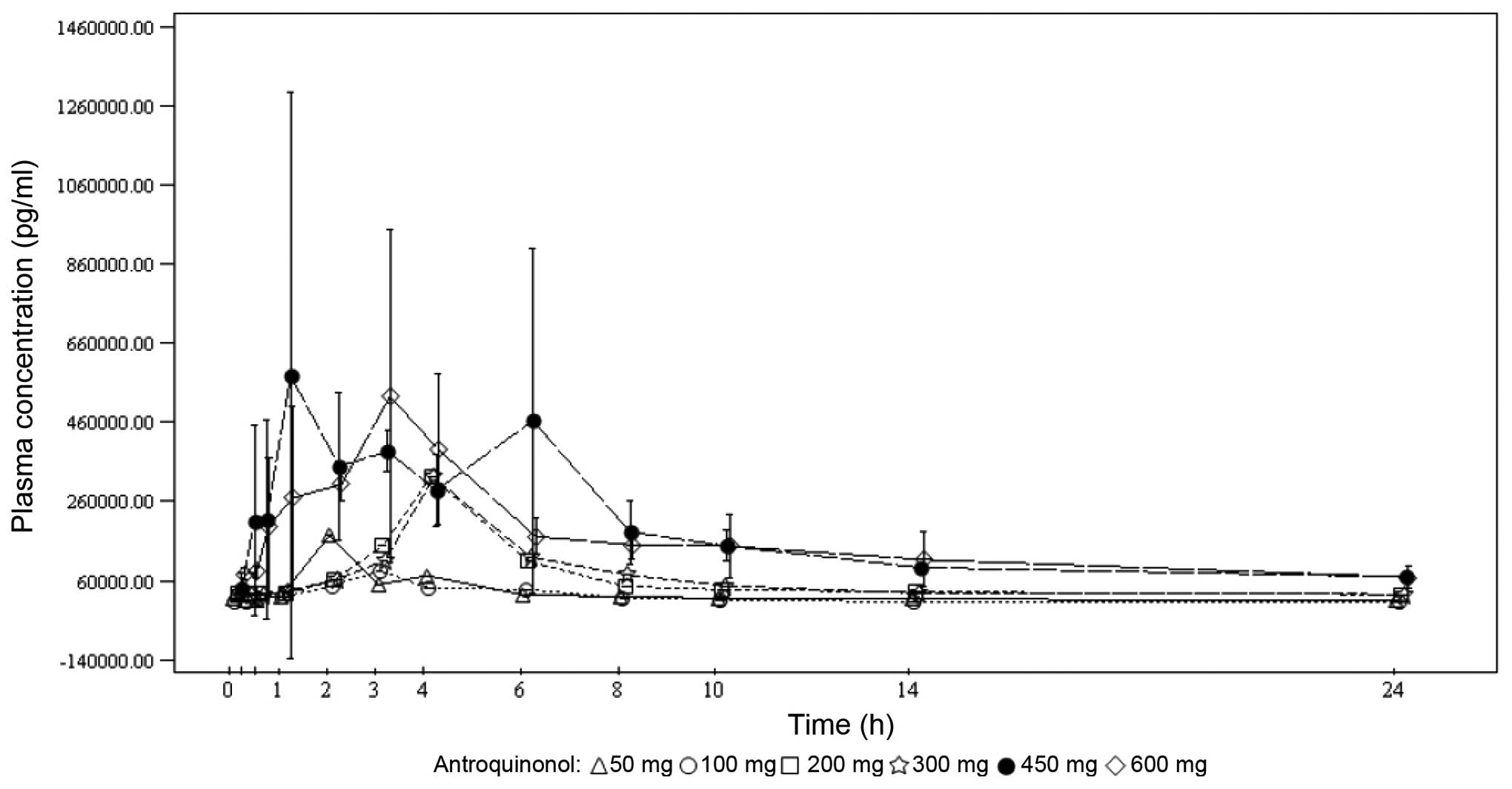A phase I multicenter study of antroquinonol in patients with metastatic non-small-cell lung cancer who have received at least two prior systemic treatment regimens, including one platinum-based chemotherapy regimen
- Authors:
- Yu-Chin Lee
- Ching-Liang Ho
- Woei-Yau Kao
- Yuh-Min Chen
-
View Affiliations
Affiliations: Sijhih Cathay General Hospital, New Taipei 221, Taiwan, R.O.C., Tri‑Service General Hospital, National Defense Medical Center, Taipei 114, Taiwan, R.O.C., Taipei Tzu Chi General Hospital, Taipei 231, Taiwan, R.O.C., School of Medicine, National Yang‑Ming University, Taipei 112, Taiwan, R.O.C.
- Published online on: September 15, 2015 https://doi.org/10.3892/mco.2015.642
-
Pages:
1375-1380
Metrics:
Total
Views: 0 (Spandidos Publications: | PMC Statistics:
)
Metrics:
Total PDF Downloads: 0 (Spandidos Publications: | PMC Statistics:
)
This article is mentioned in:
Abstract
Antroquinonol is isolated from Antrodia camphorata, a camphor tree mushroom, and is a valuable traditional Chinese herbal medicine that exhibits pharmacological activities against several diseases, including cancer. this first‑in-human phase I study of antroquinonol included patients with metastatic non-small‑cell lung cancer who had received at least two prior systemic treatment regimens. An open-label, dose escalation, pharmacokinetic (PK) study was conducted to determine the maximum tolerable dose (MTD), dose-limiting toxicities (DLTs), and safety/tolerability and preliminary efficacy profiles of antroquinonol. The patients received escalating doses of once-daily antroquinonol in 4-week cycles (up to 3 cycles). The escalated doses were 50‑600 mg. PKs were evaluated on day 1 and 28 of cycle 1. Between January, 2011 and October, 2012, 13 patients with metastatic adenocarcinoma were enrolled. No DLTs occurred in any patient at any dose level. Tmax was observed between 1.00 and 3.70 h under single‑dose conditions, and at 1.92‑4.05 h under multiple‑dose conditions. The mean elimination half‑life ranged between 1.30 and 4.33 h, independent of the treatment dose. Antroquinonol at all dose levels had a mild toxicity profile, with no reported treatment-related mortality. The most common treatment-related adverse events were diarrhea, vomiting and nausea. The best tumor response was stable disease in 3 patients. In conclusion, antroquinonol at all dose levels, administered daily for 4 weeks, was generally safe and well tolerated, without DLTs. The recommended dose level for a phase II study is ≥600 mg daily.
View References
|
1
|
Pfister DG, Johnson DH, Azzoli CG, et al:
American Society of Clinical Oncology treatment of unresectable
non-small-cell lung cancer guideline: update 2003. J Clin Oncol.
22:330–353. 2004. View Article : Google Scholar : PubMed/NCBI
|
|
2
|
Chiou JF, Wu AT, Wang WT, Kuo TH, Gelovani
JG, Lin IH, Wu CH, Chiu WT and Deng WP: A preclinical evaluation of
Antrodia camphorata alcohol extracts in the treatment of
non-small cell lung cancer using non-invasive molecular imaging.
Evid Based Complement Alternat Med. 2011:9145612011. View Article : Google Scholar : PubMed/NCBI
|
|
3
|
Chiang PC, Lin SC, Pan SL, Kuo CH, Tsai
IL, Kuo MT, Wen WC, Chen P and Guh JH: Antroquinonol displays
anticancer potential against human hepatocellular carcinoma cells:
a crucial role of AMPK and mTOR pathways. Biochem Pharmacol.
79:162–171. 2010. View Article : Google Scholar : PubMed/NCBI
|
|
4
|
Yu CC, Chiang PC, Lu PH, Kuo MT, Wen WC,
Chen P and Guh JH: Antroquinonol, a natural ubiquinone derivative,
induces a cross talk between apoptosis, autophagy and senescence in
human pancreatic carcinoma cells. J Nutrition Biochem. 23:900–907.
2012. View Article : Google Scholar
|
|
5
|
Kumar VB, Yuan TC, Liou JW, Yang CJ, Sung
PJ and Weng CF: Antroquinonol inhibits NSCLC proliferation by
altering PI3K/mTOR proteins and miRNA expression profiles. Mutation
Res. 707:42–52. 2011. View Article : Google Scholar : PubMed/NCBI
|
|
6
|
Eisenhauer EA, Therasse P, Bogaerts J, et
al: New response evaluation criteria in solid tumours: revised
RECIST guideline (version 1.1). Eur J Cancer. 45:228–247. 2009.
View Article : Google Scholar : PubMed/NCBI
|
|
7
|
Chen CC, Shiao YJ, Lin RD, Shao YY, Lai
MN, Lin CC, Ng LT and Kuo YH: Neuroprotective diterpenes from the
fruiting body of Antrodia camphorata. J Nat Prod.
69:689–691. 2006. View Article : Google Scholar : PubMed/NCBI
|
|
8
|
Lee TH, Lee CK, Tsou WL, Liu SY, Kuo MT
and Wen WC: A new cytotoxic agent from solid-state fermented
mycelium of Antrodia camphorata. Planta Med. 73:1412–1415.
2007. View Article : Google Scholar : PubMed/NCBI
|
|
9
|
Hseu YC, Chang WC, Hseu YT, Lee CY, Yech
YJ, Chen PC and Yang HL: Protection of oxidative damage by aqueous
extract from Antrodia camphorata mycelia in normal human
erythrocytes. Life Sci. 71:469–482. 2002. View Article : Google Scholar : PubMed/NCBI
|
|
10
|
Chang JM, Lee YR, Hung LM, Liu SY, Kuo MT,
Wen WC and Chen P: An extract of Antrodia camphorata mycelia
attenuates the progression of nephritis in systemic lupus
erythematosus-prone NZB/W F1 mice. Evid Based Complement Alternat
Med. 2011:4658942011. View Article : Google Scholar : PubMed/NCBI
|
|
11
|
Song TY and Yen GC: Protective effects of
fermented filtrate from Antrodia camphorata in submerged
culture against CC14-induced hepatic toxicity in rats. J Agric Food
Chem. 51:1571–1577. 2003. View Article : Google Scholar : PubMed/NCBI
|












